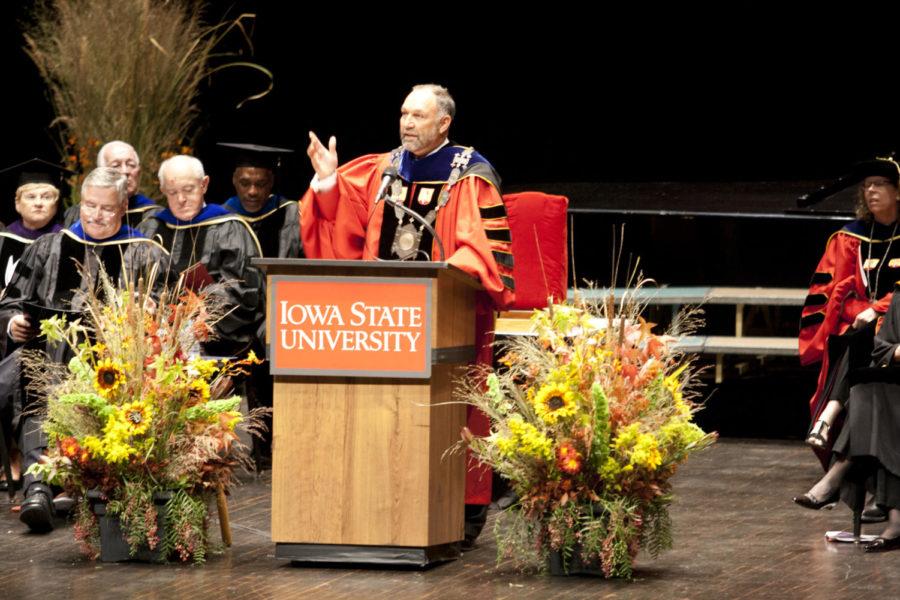Editorial: Arts, humanities and social sciences can reach out of the ivory tower, too
Photo: Lindsey Lippincott/Iowa State Daily
President Steven Leath speaks at his installation ceremony Friday, Sept. 14, in Stephens Auditorium. Leath is Iowa State’s 15th president.
September 17, 2012
ISU President Steven Leath said a great many things in the speech he gave Friday for his installation ceremony. Among the important statements that require comment and analysis is the “ivory tower” that challenges institutions of higher learning everywhere.
Leath argued Iowa State must continue to avoid the “ivory tower” problem. In fact, he said, Iowa State must be the ivory tower’s “antithesis.” Our efforts as a public, land-grant, research university must include working “side-by-side with the people” of our state. He stressed “partnerships are central to what we, as a land-grant university, do.
“We work together, whether that’s providing an education, researching a vexing problem facing agriculture or business, or helping a community to improve the quality of life for its citizens.”
Equally interspersed within his speech, Leath stressed his commitment to maintaining the excellence of the whole university, not just programs that spur economic development. Describing his plans to expand faculty in biological and physical sciences and engineering by 200 positions, he said: “We do not intend to strip faculty from other areas of the university. Our academic programs must remain strong. They are a real strength of this university.”
Leath made several nods to arts, humanities and social sciences. He noted how “bold” it was of former ISU President Raymond Hughes to hire Christian Petersen as an “artist-in-residence” during the Great Depression, lauded the College of Design for its exhibits at the Smithsonian, credited the University Museums as “exceptional programs” and recognized the Center for Excellence in the Arts and Humanities, among others.
Indeed, one of the good things about Iowa State, he said, was “the high quality of its overall total educational experience, and this means high quality in the arts, humanities and social sciences as well.”
Yet his discussion of Iowa State’s public service mission focused on what the hard sciences could do to improve Iowans’ material quality of life or economic performance, and his discussion of arts, humanities and social sciences cast them as a fine arts ivory tower that, while worth knowing, has less applicability to the wide world.
That interpretation of the disciplines’ value is rational in a market of economics, where we can say: “What a piece of work is man,” but misguided in a world where people feel, think and discern: The market of mankind, where what makes us human is valued above all else. The arts, humanities and social sciences are not mere academic exercises, but have real consequences.
Economic development affects only the economic actors playing with it, whereas the prevailing morals of society affect us all. The kind of world we live in is not characterized by the tangible things within it, but by how we put those things in it — whether we consider only the new invention, or how it fits with everything else.
Through art, foreign languages, history, literature, music, philosophy, politics and many other disciplines we acquire the worldview, the attitude of service, that is a prerequisite to citizenship and serving others. It is through these liberal arts that we acquire the standards by which we judge and evaluate the effects of developments in chemistry, physics, engineering and other natural sciences.
Thus we respectfully remind Leath the land-grant college is supposed to bring both the liberal and the practical arts, equally, out of the ivory tower.







